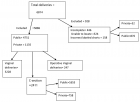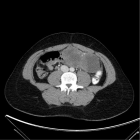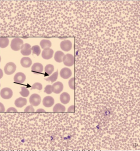Abstract
Research Article
The Comparison of Brachial Artery Parameters between the Clinical Cuff, Pneumatic Controlled Air Band (KAATSU), and Elastic Band during Blood Flow Restriction at the same Perceived Tightness
Alexandra Passos Gaspar*, De Matos LDNJ, Amorim S, De Oliveira RS, Fernandes RV and Laurentino G
Published: 30 April, 2024 | Volume 9 - Issue 2 | Pages: 015-021
The Blood Flow Restriction (BFR) technique is based on cuffs connected to a pressure device that induces partial arterial inflow. BFR combined with exercise has already been proven to increase strength, muscle mass, and muscular endurance. However, some BFR devices with pneumatic air bands, such as KAATSU (KA), are expensive and less accessible, making either a Sphygmomanometer Cuff (SC) or Elastic Band (EB) an interesting alternative. However, vascular parameters in response to blood flow restriction during KA, EB, and SC have not yet been compared.
Purpose: The aim of this study was to compare the brachial blood flow behavior during restriction using bands such as KA, SC, and EB on the same perceived tightness.
Methods: Thirty healthy men participated in a prospective crossover study. Participants underwent blood flow measurements before and during KA, SC, and EB use, with KA-perceived tightness taken as a reference. The brachial blood flow volume, the diameter of the artery, and blood flow velocity were measured before and immediately after the cuff’s inflation at a specific tightness.
Results: Blood flow volume was significantly reduced in KA (52%, ES: 1.38), SC (61.7%, ES: 1.29), and EB (41.5%, ES: 1.22) (p <.0001). In addition, blood flow velocity was significantly reduced in KA (12.9%, ES: 0.74), SC (23.8%, ES: 1.02), and EB (25.6%, ES: 1.02) (p <.0001). No significant changes were observed in the diameter of the brachial artery for any condition (p > 0.05).
Conclusion: Brachial blood flow behavior was similar between pneumatic controlled air band (KA), SC, and EB cuffs at the same perceived tightness.
Highlights
• Growing evidence suggests that blood flow restriction is an interesting technique to improve muscle mass and strength with less articular impact and practical applications are yet to be explored.
• Different bands and devices have been used to apply in patients the technique and but, methods are still too heterogenous to be compared in the expected results.
• Although studies in the BFR literature have shown that blood flow restriction is applied according to Arterial Occlusion Pressure (AOP) and the devices and techniques are trying to standardize it, there is still a lack of information on this matter. More studies are needed to evaluate their similarity and also understand their safety.
Read Full Article HTML DOI: 10.29328/journal.jsmt.1001076 Cite this Article Read Full Article PDF
Keywords:
Blood flow restriction; KAATSU; Perceived tightness; Sphygmomanometer cuff; Practical blood flow restriction
References
- Sato Y. The history and future of KAATSU Training. International Journal of KAATSU Training Research. 2005; 1(1): 1–5. https://doi.org/10.3806/ijktr.1.1
- Gladden J, Wernecke C, Rector S, Tecson K, McCullough P. Pilot safety study: The use of Vasper, a novel blood flow restriction exercise, in healthy adults. J Exerc Phys. 2016; 19(2):99–105
- McEwen JA, Owens JG, Jeyasurya J. Why is it Crucial to Use Personalized Occlusion Pressures in Blood Flow Restriction (BFR) Rehabilitation? Journal of Medical and Biological Engineering. 2018, April 9; 39(2):173–177. https://doi.org/10.1007/s40846-018-0397-7
- Wernbom M, Apro W, Paulsen G, Nilsen TS, Blomstrand E, Raastad T. Acute low-load resistance exercise with and without blood flow restriction increased protein signalling and number of satellite cells in human skeletal muscle. Eur J Appl Physiol. 2013 Dec;113(12):2953-65. doi: 10.1007/s00421-013-2733-5. PMID: 24078212.
- Jessee MB, Buckner SL, Mouser JG, Mattocks KT, Dankel SJ, Abe T, Bell ZW, Bentley JP, Loenneke JP. Muscle Adaptations to High-Load Training and Very Low-Load Training With and Without Blood Flow Restriction. Front Physiol. 2018 Oct 16;9:1448. doi: 10.3389/fphys.2018.01448. PMID: 30386254; PMCID: PMC6198179.
- Nakajima T, Kurano M, Iida H, Takano H, Oonuma H, Morita T, Meguro K, Sato Y, Nagata T, KAATSU Training Group. Use and safety of KAATSU training:Results of a national survey. International Journal of KAATSU Training Research. 2006; 2(1):5–13. https://doi.org/10.3806/ijktr.2.5
- Yow BG, Tennent DJ, Dowd TC, Loenneke JP, Owens JG. Blood Flow Restriction Training After Achilles Tendon Rupture. J Foot Ankle Surg. 2018 May-Jun;57(3):635-638. doi: 10.1053/j.jfas.2017.11.008. Epub 2018 Feb 21. PMID: 29477554.
- Takarada Y, Nakamura Y, Aruga S, Onda T, Miyazaki S, Ishii N. Rapid increase in plasma growth hormone after low-intensity resistance exercise with vascular occlusion. J Appl Physiol (1985). 2000 Jan;88(1):61-5. doi: 10.1152/jappl.2000.88.1.61. PMID: 10642363.
- Takarada Y, Takazawa H, Ishii N. Applications of vascular occlusion diminish disuse atrophy of knee extensor muscles. Med Sci Sports Exerc. 2000 Dec;32(12):2035-9. doi: 10.1097/00005768-200012000-00011. PMID: 11128848.
- Shinohara M, Kouzaki M, Yoshihisa T, Fukunaga T. Efficacy of tourniquet ischemia for strength training with low resistance. Eur J Appl Physiol Occup Physiol. 1998;77(1-2):189-91. doi: 10.1007/s004210050319. PMID: 9459541.
- Rossow LM, Fahs CA, Loenneke JP, Thiebaud RS, Sherk VD, Abe T, Bemben MG. Cardiovascular and perceptual responses to blood-flow-restricted resistance exercise with differing restrictive cuffs. Clin Physiol Funct Imaging. 2012 Sep;32(5):331-7. doi: 10.1111/j.1475-097X.2012.01131.x. Epub 2012 Apr 4. PMID: 22856338.
- Wilson JM, Lowery RP, Joy JM, Loenneke JP, Naimo MA. Practical blood flow restriction training increases acute determinants of hypertrophy without increasing indices of muscle damage. J Strength Cond Res. 2013 Nov;27(11):3068-75. doi: 10.1519/JSC.0b013e31828a1ffa. PMID: 23446173.
- Lowery RP, Joy JM, Loenneke JP, de Souza EO, Machado M, Dudeck JE, Wilson JM. Practical blood flow restriction training increases muscle hypertrophy during a periodized resistance training programme. Clin Physiol Funct Imaging. 2014 Jul;34(4):317-21. doi: 10.1111/cpf.12099. Epub 2013 Nov 4. PMID: 24188499.
- Lixandrão ME, Ugrinowitsch C, Berton R, Vechin FC, Conceição MS, Damas F, Libardi CA, Roschel H. Magnitude of Muscle Strength and Mass Adaptations Between High-Load Resistance Training Versus Low-Load Resistance Training Associated with Blood-Flow Restriction: A Systematic Review and Meta-Analysis. Sports Med. 2018 Feb;48(2):361-378. doi: 10.1007/s40279-017-0795-y. PMID: 29043659.
- Stray-Gundersen S, Wooten S, Tanaka H. Walking With Leg Blood Flow Restriction: Wide-Rigid Cuffs vs. Narrow-Elastic Bands. Front Physiol. 2020 May 29;11:568. doi: 10.3389/fphys.2020.00568. PMID: 32547424; PMCID: PMC7273976.
- Bell ZW, Dankel SJ, Mattocks KT, Buckner SL, Jessee MB, Mouser JG, Abe T, Loenneke JP. An investigation into setting the blood flow restriction pressure based on perception of tightness. Physiol Meas. 2018 Oct 19;39(10):105006. doi: 10.1088/1361-6579/aae140. PMID: 30211696.
- Bell ZW, Dankel SJ, Spitz RW, Chatakondi RN, Abe T, Loenneke JP. The Perceived Tightness Scale Does Not Provide Reliable Estimates of Blood Flow Restriction Pressure. J Sport Rehabil. 2019 Sep 24;29(4):516-518. doi: 10.1123/jsr.2018-0439. PMID: 31553951.
- Thijssen DH, Black MA, Pyke KE, Padilla J, Atkinson G, Harris RA, Parker B, Widlansky ME, Tschakovsky ME, Green DJ. Assessment of flow-mediated dilation in humans: a methodological and physiological guideline. Am J Physiol Heart Circ Physiol. 2011 Jan;300(1):H2-12. doi: 10.1152/ajpheart.00471.2010. Epub 2010 Oct 15. PMID: 20952670; PMCID: PMC3023245.
- Weatherholt AM, Vanwye WR, Lohmann J, Owens JG. The Effect of Cuff Width for Determining Limb Occlusion Pressure: A Comparison of Blood Flow Restriction Devices. Int J Exerc Sci. 2019 Jan 1;12(3):136-143. PMID: 30761200; PMCID: PMC6355123.
- Abe T, Mouser JG, Dankel SJ, Bell ZW, Buckner SL, Mattocks KT, Jessee MB, Loenneke JP. A method to standardize the blood flow restriction pressure by an elastic cuff. Scand J Med Sci Sports. 2019 Mar;29(3):329-335. doi: 10.1111/sms.13340. Epub 2018 Dec 9. PMID: 30468528.
- Laurentino GC, Loenneke JP, Teixeira EL, Nakajima E, Iared W, Tricoli V. The Effect of Cuff Width on Muscle Adaptations after Blood Flow Restriction Training. Med Sci Sports Exerc. 2016 May;48(5):920-5. doi: 10.1249/MSS.0000000000000833. PMID: 26656773.
- Conceição MS, Junior EMM, Telles GD, Libardi CA, Castro A, Andrade ALL, Brum PC, Urias Ú, Kurauti MA, Júnior JMC, Boschero AC, Cavaglieri CR, Camera DM, Chacon-Mikahil MPT. Augmented Anabolic Responses after 8-wk Cycling with Blood Flow Restriction. Med Sci Sports Exerc. 2019 Jan;51(1):84-93. doi: 10.1249/MSS.0000000000001755. PMID: 30113523.
- Scott BR, Loenneke JP, Slattery KM, Dascombe BJ. Blood flow restricted exercise for athletes: A review of available evidence. J Sci Med Sport. 2016 May;19(5):360-7. doi: 10.1016/j.jsams.2015.04.014. Epub 2015 May 9. PMID: 26118847.
- Barbalho M, Rocha AC, Seus TL, Raiol R, Del Vecchio FB, Coswig VS. Addition of blood flow restriction to passive mobilization reduces the rate of muscle wasting in elderly patients in the intensive care unit: a within-patient randomized trial. Clin Rehabil. 2019 Feb;33(2):233-240. doi: 10.1177/0269215518801440. Epub 2018 Sep 24. PMID: 30246555.
- Centner C, Wiegel P, Gollhofer A, König D. Correction to: Effects of Blood Flow Restriction Training on Muscular Strength and Hypertrophy in Older Individuals: A Systematic Review and Meta-Analysis. Sports Med. 2019 Jan;49(1):109-111. doi: 10.1007/s40279-018-1013-2. Erratum for: Sports Med. 2019 Jan;49(1):95-108. PMID: 30414044; PMCID: PMC6828275.
- Noto T, Hashimoto G, Takagi T, Awaya T, Araki T, Shiba M, Iijima R, Hara H, Moroi M, Nakamura M, Sugi K. Paget-Schroetter Syndrome Resulting from Thoracic Outlet Syndrome and KAATSU Training. Intern Med. 2017 Oct 1;56(19):2595-2601. doi: 10.2169/internalmedicine.7937-16. Epub 2017 Sep 6. PMID: 28883228; PMCID: PMC5658525.
- Fukuda T, Yasuda T, Fukumura K, Iida H, Morita T, Sato Y, Nakajima T. Low-intensity kaatsu resistance exercises using an elastic band enhance muscle activation in patients with cardiovascular diseases. International Journal of KAATSU Training Research. 2013; 9(1):1–5. https://doi.org/10.3806/ijktr.9.1
- Pereira-Neto EA, Lewthwaite H, Boyle T, Johnston K, Bennett H, Williams MT. Effects of exercise training with blood flow restriction on vascular function in adults: a systematic review and meta-analysis. PeerJ. 2021 Jul 7;9:e11554. doi: 10.7717/peerj.11554. PMID: 34277146; PMCID: PMC8272459.
- Miyachi M, Donato AJ, Yamamoto K, Takahashi K, Gates PE, Moreau KL, Tanaka H. Greater age-related reductions in central arterial compliance in resistance-trained men. Hypertension. 2003 Jan;41(1):130-5. doi: 10.1161/01.hyp.0000047649.62181.88. PMID: 12511542.
- Miyachi M, Kawano H, Sugawara J, Takahashi K, Hayashi K, Yamazaki K, Tabata I, Tanaka H. Unfavorable effects of resistance training on central arterial compliance: a randomized intervention study. Circulation. 2004 Nov 2;110(18):2858-63. doi: 10.1161/01.CIR.0000146380.08401.99. Epub 2004 Oct 18. PMID: 15492301.
- Fahs CA, Loenneke JP, Rossow LM, Tiebaud RS, Bemben MG. Methodological considerations for blood flow restricted resistance exercise. Journal of Trainology. 2012; 1(1):14–22. https://doi.org/10.17338/trainology.1.1_14
- Loenneke JP, Fahs CA, Rossow LM, Thiebaud RS, Mattocks KT, Abe T, Bemben MG. Blood flow restriction pressure recommendations: a tale of two cuffs. Front Physiol. 2013 Sep 10;4:249. doi: 10.3389/fphys.2013.00249. PMID: 24058346; PMCID: PMC3767914.
- Loenneke JP, Fahs CA, Rossow LM, Sherk VD, Thiebaud RS, Abe T, Bemben DA, Bemben MG. Effects of cuff width on arterial occlusion: implications for blood flow restricted exercise. Eur J Appl Physiol. 2012 Aug;112(8):2903-12. doi: 10.1007/s00421-011-2266-8. Epub 2011 Dec 6. PMID: 22143843; PMCID: PMC4133131.
- Patterson SD, Hughes L, Warmington S, Burr J, Scott BR, Owens J, Abe T, Nielsen JL, Libardi CA, Laurentino G, Neto GR, Brandner C, Martin-Hernandez J, Loenneke J. Blood Flow Restriction Exercise: Considerations of Methodology, Application, and Safety. Front Physiol. 2019 May 15;10:533. doi: 10.3389/fphys.2019.00533. Erratum in: Front Physiol. 2019 Oct 22;10:1332. PMID: 31156448; PMCID: PMC6530612.
Figures:
Similar Articles
-
Contractions of athlete’s foot and its muscle oxygenationA Paiziev*,F Kerimov. Contractions of athlete’s foot and its muscle oxygenation. . 2018 doi: 10.29328/journal.jsmt.1001033; 3: 096-101
-
The Comparison of Brachial Artery Parameters between the Clinical Cuff, Pneumatic Controlled Air Band (KAATSU), and Elastic Band during Blood Flow Restriction at the same Perceived TightnessAlexandra Passos Gaspar*, De Matos LDNJ, Amorim S, De Oliveira RS, Fernandes RV, Laurentino G. The Comparison of Brachial Artery Parameters between the Clinical Cuff, Pneumatic Controlled Air Band (KAATSU), and Elastic Band during Blood Flow Restriction at the same Perceived Tightness. . 2024 doi: 10.29328/journal.jsmt.1001076; 9: 015-021
Recently Viewed
-
Pneumothorax as Complication of CT Guided Lung Biopsy: Frequency, Severity and Assessment of Risk FactorsGaurav Raj*,Neha Kumari,Neha Singh,Kaustubh Gupta,Anurag Gupta,Pradyuman Singh,Hemant Gupta. Pneumothorax as Complication of CT Guided Lung Biopsy: Frequency, Severity and Assessment of Risk Factors. J Radiol Oncol. 2025: doi: 10.29328/journal.jro.1001075; 9: 012-016
-
The Police Power of the National Health Surveillance Agency – ANVISADimas Augusto da Silva*,Rafaela Marinho da Silva. The Police Power of the National Health Surveillance Agency – ANVISA. Arch Cancer Sci Ther. 2024: doi: 10.29328/journal.acst.1001046; 8: 063-076
-
A Comparative Study of Serum Sodium and Potassium Levels across the Three Trimesters of PregnancyOtoikhila OC and Seriki SA*. A Comparative Study of Serum Sodium and Potassium Levels across the Three Trimesters of Pregnancy. Clin J Obstet Gynecol. 2023: doi: 10.29328/journal.cjog.1001137; 6: 108-116
-
Chaos to Cosmos: Quantum Whispers and the Cosmic GenesisOwais Farooq*,Romana Zahoor*. Chaos to Cosmos: Quantum Whispers and the Cosmic Genesis. Int J Phys Res Appl. 2025: doi: 10.29328/journal.ijpra.1001107; 8: 017-023
-
Phytochemical Compounds and the Antifungal Activity of Centaurium pulchellum Ethanol Extracts in IraqNoor Jawad Khadhum, Neepal Imtair Al-Garaawi*, Antethar Jabbar Al-Edani. Phytochemical Compounds and the Antifungal Activity of Centaurium pulchellum Ethanol Extracts in Iraq. J Plant Sci Phytopathol. 2024: doi: 10.29328/journal.jpsp.1001137; 8: 079-083
Most Viewed
-
Evaluation of Biostimulants Based on Recovered Protein Hydrolysates from Animal By-products as Plant Growth EnhancersH Pérez-Aguilar*, M Lacruz-Asaro, F Arán-Ais. Evaluation of Biostimulants Based on Recovered Protein Hydrolysates from Animal By-products as Plant Growth Enhancers. J Plant Sci Phytopathol. 2023 doi: 10.29328/journal.jpsp.1001104; 7: 042-047
-
Sinonasal Myxoma Extending into the Orbit in a 4-Year Old: A Case PresentationJulian A Purrinos*, Ramzi Younis. Sinonasal Myxoma Extending into the Orbit in a 4-Year Old: A Case Presentation. Arch Case Rep. 2024 doi: 10.29328/journal.acr.1001099; 8: 075-077
-
Feasibility study of magnetic sensing for detecting single-neuron action potentialsDenis Tonini,Kai Wu,Renata Saha,Jian-Ping Wang*. Feasibility study of magnetic sensing for detecting single-neuron action potentials. Ann Biomed Sci Eng. 2022 doi: 10.29328/journal.abse.1001018; 6: 019-029
-
Pediatric Dysgerminoma: Unveiling a Rare Ovarian TumorFaten Limaiem*, Khalil Saffar, Ahmed Halouani. Pediatric Dysgerminoma: Unveiling a Rare Ovarian Tumor. Arch Case Rep. 2024 doi: 10.29328/journal.acr.1001087; 8: 010-013
-
Physical activity can change the physiological and psychological circumstances during COVID-19 pandemic: A narrative reviewKhashayar Maroufi*. Physical activity can change the physiological and psychological circumstances during COVID-19 pandemic: A narrative review. J Sports Med Ther. 2021 doi: 10.29328/journal.jsmt.1001051; 6: 001-007

HSPI: We're glad you're here. Please click "create a new Query" if you are a new visitor to our website and need further information from us.
If you are already a member of our network and need to keep track of any developments regarding a question you have already submitted, click "take me to my Query."


























































































































































